The Samsung 750 EVO (120GB & 250GB) SSD Review: A Return To Planar NAND
by Billy Tallis on April 22, 2016 8:00 AM ESTSequential Read Performance
The sequential read test requests 128kB blocks and tests queue depths ranging from 1 to 32. The queue depth is doubled every three minutes, for a total test duration of 18 minutes. The test spans the entire drive, and the drive is filled before the test begins. The primary score we report is an average of performances at queue depths 1, 2 and 4, as client usage typically consists mostly of low queue depth operations.
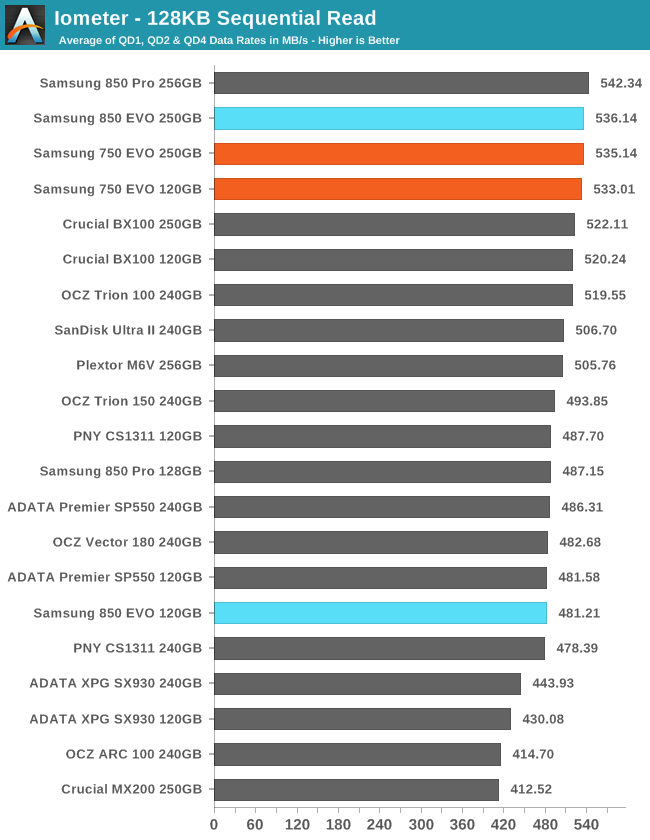
The 250GB 750 EVO comes in right behind the 850 EVO and Pro for sequential read speed, and the 120GB 750 EVO surprises by coming in fourth, significantly ahead of both the 120GB 850 EVO and 128GB 850 Pro.

Power consumption for the 750 EVO is a little high but nothing concerning. Only a few MLC drives distinguish themselves with particularly high efficiency during sequential reads.
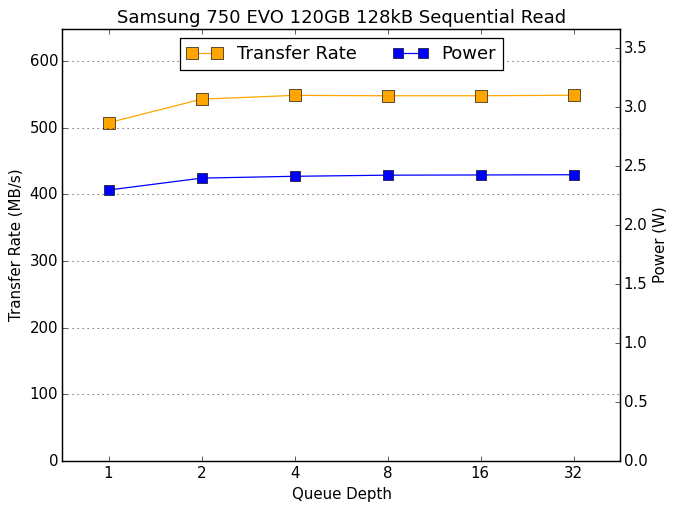 |
|||||||||
The high performance score of the 750 EVOs is due primarily to their unusually good QD1 speeds, which are quite close to the limit reached at higher queue depths.
Sequential Write Performance
The sequential write test writes 128kB blocks and tests queue depths ranging from 1 to 32. The queue depth is doubled every three minutes, for a total test duration of 18 minutes. The test spans the entire drive, and the drive is filled before the test begins. The primary score we report is an average of performances at queue depths 1, 2 and 4, as client usage typically consists mostly of low queue depth operations.
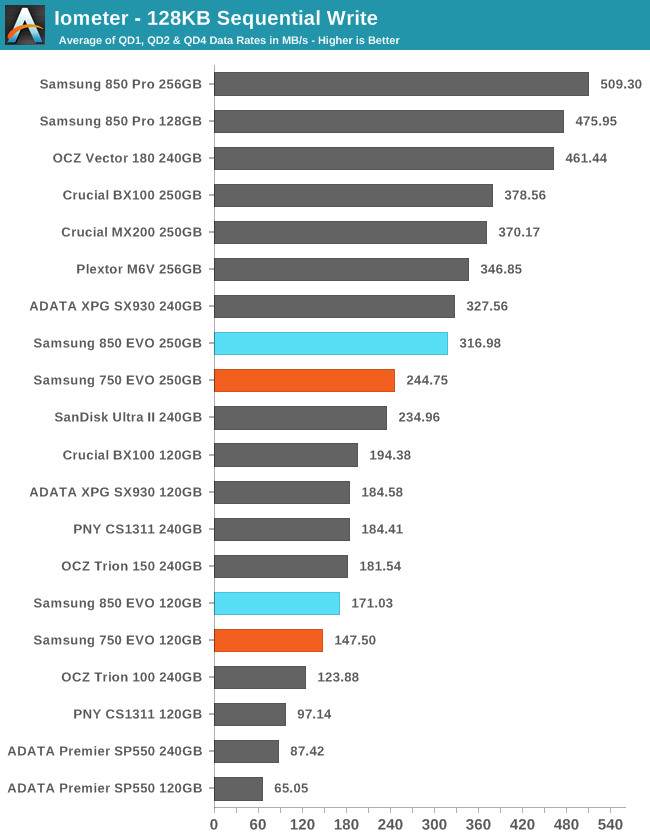
Sequential write speeds of the 750 EVO are significantly lower than the 850 EVO and not competitive with MLC drives, but are in the lead among planar TLC drives.
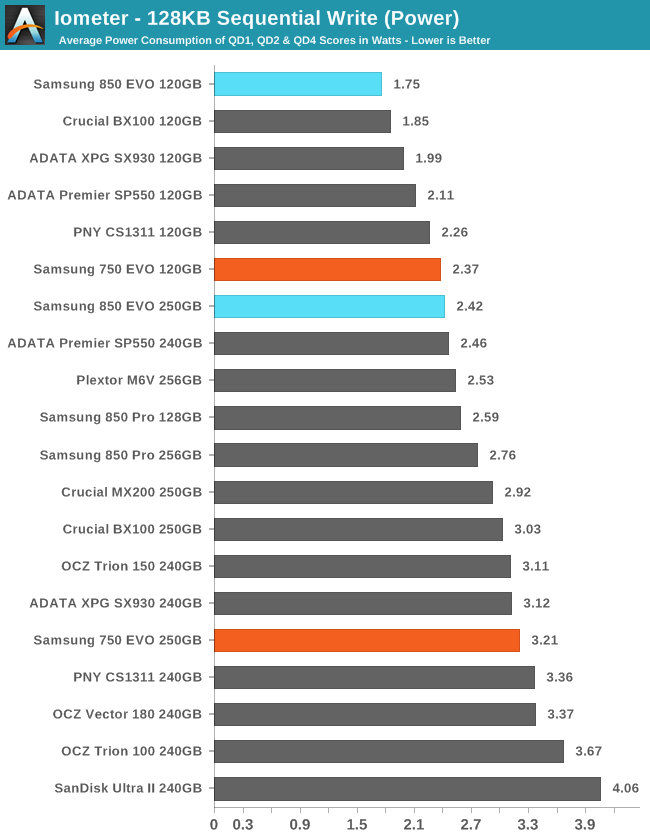
Power consumption for the 750 EVO is significantly higher than the 850 EVO, but it is still more efficient than the planar TLC competitors.
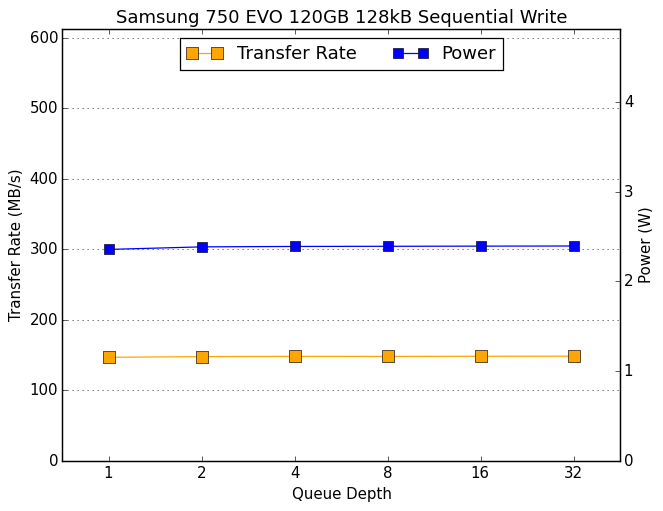 |
|||||||||
Most drives show no scaling with queue depth in this test, and the 750 EVO follows suit.










109 Comments
View All Comments
Ascaris - Thursday, April 28, 2016 - link
Isn't that the truth! Nearly every item comes with glowing reviews mixed in with "mine died in xx time, and I am never going to buy from $company ever again." Consumer routers and hard drives seem particularly bad in that way-- if I avoided all of the ones with horror stories, I'd never have either of them.Another thing people tend to overlook in reliability is the role of a good power supply. A cheap PSU can slowly sap the life from all the components in the system by introducing unacceptable levels of ripple, and you'd never know that was a cause or partial cause of the failure. On a laptop with the brick-style power supply, it is a good idea to replace a failed unit with an OEM unit of recent manufacture (less chance of dried-up caps) than some eBay special of unknown origin (other than to say China, which is where the OEM one came from too, almost certainly).
For desktops, the PSU is something people sometimes skimp on. I've never actually had a prebuilt desktop, but I would bet a lot of them have cheap PSUs, as it is probably a place where pennies can be pinched without a huge increase in RMAs before the warranty expires. I looked at new PCs on the site of one of the major online sellers about a year ago, and I was surprised at how many current models still had 120/240v switches on the PSU, which shows that they are older models without active PFC. That does not necessarily mean they're of poor quality, but it does make me wonder about them.
BrokenCrayons - Friday, April 22, 2016 - link
I think it needs to come down in price before it'll be an acceptable sort of purchase.zepi - Friday, April 22, 2016 - link
SSD's have lost a lot by being so hamstrung by their interfaces. CPU's have limited number of PCI-e connections and motherboards very little space for M.2 slots. SATA 3 is slow and bad protocol for SSD so that race to the bottom is only thing that is of any interest in 2.5" drives.TheinsanegamerN - Friday, April 22, 2016 - link
SATA 3 may not be super fast, but the only observable difference, IME, between an m.2 drive and a sata drive was 2 seconds on boot. Unless you are a content creator working with laarge video/pictures, m.2 has little to offer over sata.Especially given that 2TB sata ssds exist, while m.2 is limited to 512GB, and that 512GB m.2 is more expensive than a 1TB sata ssd. And the ehat that m.2 drives give off compared to sata.
Margalus - Friday, April 22, 2016 - link
It may be "cheap", but it's worthless in my opinion. Only 120GB or 250GB, pretty much too small for anything except a boot drive. If there are no 1TB drives, why bother?TheinsanegamerN - Friday, April 22, 2016 - link
Believe it or not, many people could fit their computer needs in 250GB.I only use about 500GB between all of the games I actually play, and the OS itself.
Meteor2 - Friday, April 22, 2016 - link
Mmmm, I think a lot of people have digital media collections now. I have no DVDs or Blu Rays, but 600 GB of films and TV series.barleyguy - Friday, April 22, 2016 - link
Video doesn't need SSD levels of performance. Any modern spinning disk is fast enough to play video, even up to 4K.Personally, my video server machine is a 250 GB MX200 M-SATA SSD and a 4 TB hard drive.
Meteor2 - Saturday, April 23, 2016 - link
Absolutely but I want a single high-performance disc.Bleakwise - Sunday, April 24, 2016 - link
Why do you want an SSD for cold storage backups? That's just silly.